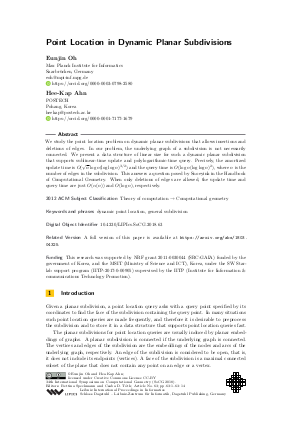Point Location in Dynamic Planar Subdivisions
Authors Eunjin Oh, Hee-Kap Ahn
-
Part of:
Volume:
34th International Symposium on Computational Geometry (SoCG 2018)
Part of: Series: Leibniz International Proceedings in Informatics (LIPIcs)
Part of: Conference: Symposium on Computational Geometry (SoCG) - License:
 Creative Commons Attribution 3.0 Unported license
Creative Commons Attribution 3.0 Unported license
- Publication Date: 2018-06-08
File

PDF
LIPIcs.SoCG.2018.63.pdf
- Filesize: 475 kB
- 14 pages
Document Identifiers
Subject Classification
Keywords
- dynamic point location
- general subdivision
Metrics
- Access Statistics
-
Total Accesses (updated on a weekly basis)
0Document
0Metadata
Abstract
We study the point location problem on dynamic planar subdivisions that allows insertions and deletions of edges. In our problem, the underlying graph of a subdivision is not necessarily connected. We present a data structure of linear size for such a dynamic planar subdivision that supports sublinear-time update and polylogarithmic-time query. Precisely, the amortized update time is O(sqrt{n}log n(log log n)^{3/2}) and the query time is O(log n(log log n)^2), where n is the number of edges in the subdivision. This answers a question posed by Snoeyink in the Handbook of Computational Geometry. When only deletions of edges are allowed, the update time and query time are just O(alpha(n)) and O(log n), respectively.
Cite As Get BibTex
Eunjin Oh and Hee-Kap Ahn. Point Location in Dynamic Planar Subdivisions. In 34th International Symposium on Computational Geometry (SoCG 2018). Leibniz International Proceedings in Informatics (LIPIcs), Volume 99, pp. 63:1-63:14, Schloss Dagstuhl – Leibniz-Zentrum für Informatik (2018)
https://doi.org/10.4230/LIPIcs.SoCG.2018.63
BibTex
@InProceedings{oh_et_al:LIPIcs.SoCG.2018.63,
author = {Oh, Eunjin and Ahn, Hee-Kap},
title = {{Point Location in Dynamic Planar Subdivisions}},
booktitle = {34th International Symposium on Computational Geometry (SoCG 2018)},
pages = {63:1--63:14},
series = {Leibniz International Proceedings in Informatics (LIPIcs)},
ISBN = {978-3-95977-066-8},
ISSN = {1868-8969},
year = {2018},
volume = {99},
editor = {Speckmann, Bettina and T\'{o}th, Csaba D.},
publisher = {Schloss Dagstuhl -- Leibniz-Zentrum f{\"u}r Informatik},
address = {Dagstuhl, Germany},
URL = {https://drops.dagstuhl.de/entities/document/10.4230/LIPIcs.SoCG.2018.63},
URN = {urn:nbn:de:0030-drops-87769},
doi = {10.4230/LIPIcs.SoCG.2018.63},
annote = {Keywords: dynamic point location, general subdivision}
}
Author Details
References
-
Alfred V. Aho and John E. Hopcroft. The Design and Analysis of Computer Algorithms. Addison-Wesley Longman Publishing Co., Inc., 1974.

-
Lars Arge, Gerth Stølting Brodal, and Loukas Georgiadis. Improved dynamic planar point location. In Proceedings of the 47th Annual IEEE Symposium on Foundations of Computer Science (FOCS 2006), pages 305-314, 2006.

-
Hanna Baumgarten, Hermann Jung, and Kurt Mehlhorn. Dynamic point location in general subdivisions. Journal of Algorithms, 17(3):342-380, 1994.

-
Jon Louis Bentley and James B Saxe. Decomposable searching problems 1: Static-to-dynamic transformations. Journal of Algorithms, 1(4):301-358, 1980.

-
Timothy M. Chan and Yakov Nekrich. Towards an optimal method for dynamic planar point location. In Proceedings of the 56th Annual IEEE Symposium on Foundations of Computer Science (FOCS 2015), pages 390-409, 2015.

-
Siu-Wing Cheng and Ravi Janardan. New results on dynamic planar point location. SIAM Journal on Computing, 21(5):972-999, 1992.

-
Mark de Berg, Otfried Cheong, Marc van Kreveld, and Mark Overmars. Computational Geometry: Algorithms and Applications. Springer-Verlag TELOS, 2008.

-
Jiří Matousěk. Efficient partition trees. Discrete &Computational Geometry, 8(3), 1992.

-
Mark H. Overmars. Range searching in a set of line segments. Technical report, Rijksuniversiteit Utrecht, 1983.

-
Mark H. Overmars and Jan van Leeuwen. Worst-case optimal insertion and deletion methods for decomposable searching problem. Information Processing Letters, 12(4):168-173, 1981.

-
Neil Sarnak and Robert E. Tarjan. Planar point location using persistent search trees. Communications of the ACM, 29(7):669-679, 1986.

-
Jack Snoeyink. Point location. In Handbook of Discrete and Computational Geometry, Third Edition, pages 1005-1023. Chapman and Hall/CRC, 2017.

-
Robert Endre Tarjan. Efficiency of a good but not linear set union algorithm. Journal of the ACM, 22(2):215-225, 1975.

